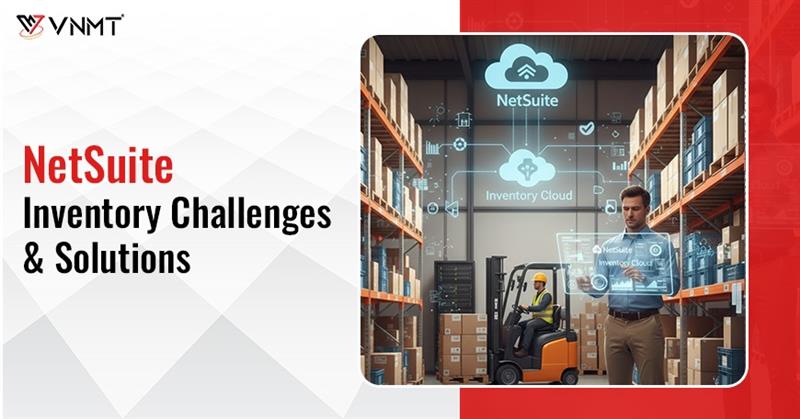Have you noticed that even though NetSuite is a powerful ERP, many businesses still face issues like stockouts, overstocking, or problems with order fulfillment?
Think of a retail brand that starts using NetSuite to make its operations smoother. But after a few months, its warehouse is filled with slow-moving products, customers are unhappy about delayed deliveries, and managers are stuck fixing inventory errors using spreadsheets.
Does that sound familiar?
The reality is that NetSuite is a competent system, but it is not a quick fix for everything. In fact, most NetSuite inventory problems don’t happen because the software is weak. They typically occur when the system is misconfigured, underutilized, or not fully integrated into daily operations. There are numerous NetSuite inventory issues such as inaccurate data, poor visibility or supply chain disruptions that can easily hinder businesses from realizing the full potential of NetSuite.
In this blog, we will examine the five most common NetSuite inventory challenges and provide solutions to address them, enabling your business to run smoothly and keep your customers satisfied.
Why Businesses Face Inventory Challenges in NetSuite
Even with a robust system like NetSuite, businesses often encounter inventory challenges due to internal gaps and operational mistakes.
- Over-Reliance on Legacy Methods or Spreadsheets
Many businesses still use outdated spreadsheets or manual methods in conjunction with NetSuite. This creates duplicate work, increases human error, and prevents businesses from fully leveraging the benefits of automation features. As a result, inventory accuracy drops, and decision-making becomes slower.
- Lack of Employee Training on NetSuite Features
NetSuite offers powerful tools, but employees may not be familiar with how to utilize advanced functions without proper training. This leads to underutilization of key features such as demand planning, reorder points, or lot tracking that results in inefficiencies.
- Failure to Properly Configure NetSuite Modules
NetSuite inventory setup errors are a common challenge that users face. If settings like item categorization, reorder rules or warehouse mapping are not configured correctly, the system produces inaccurate data. This causes problems with stock visibility and order fulfillment.
- Rapid Growth of Businesses Leading to Scaling Issues
As companies expand, their inventory operations become more complex. Businesses that do not optimize their NetSuite setup to handle multiple warehouses, global suppliers, or higher order volumes struggle with scalability. This often leads to stockouts, backorders, and fulfillment delays.
Top 5 NetSuite Inventory Challenges Businesses Face
Managing inventory in NetSuite can be tricky if businesses rely on outdated processes or fail to use its features effectively. Below are the five most common NetSuite inventory issues companies face.
- Inaccurate Data and Poor Visibility in NetSuite
Inventory data often becomes unreliable when businesses rely on manual entry or spreadsheets for data management. This can cause NetSuite inventory problems, such as “underwater inventory,” where items appear as sold despite being out of stock. Inaccurate data leads to distorted financial reports, wrong decisions, and higher audit risks. Without real-time visibility, managers struggle to track stock movement effectively across the supply chain.
- Stock Imbalances and Forecasting Errors
Maintaining the right balance between too much and too little stock is one of the common NetSuite ERP problems for many users. Overstocking locks up capital and increases storage costs, while understocking results in lost sales and unhappy customers. Obsolete or slow-moving products add further waste and holding costs. These problems usually stem from weak demand forecasting and inconsistent reporting.
- Multi-Location Tracking Difficulties
As businesses expand, their inventory often becomes distributed across multiple warehouses or retail outlets. Without proper synchronization in NetSuite, one location may face shortages while another has excess stock. This imbalance increases transfer costs, delays fulfillment, and reduces efficiency. Poor visibility across locations also makes it harder to plan replenishment and allocate resources effectively.
- Inefficient Order Fulfillment Workflows
Order fulfillment becomes complicated when picking, packing, and shipping are not optimized in NetSuite. Errors such as overselling, delayed deliveries or wrong shipments are common outcomes. Inefficiencies at this stage increase return rates, erode customer trust, and incur additional costs. Many of these issues arise because businesses fail to utilize NetSuite’s automation features to streamline their workflows.
- Supply Chain Disruptions and System Gaps
External factors such as supplier delays, global shipping challenges and sudden demand shifts make inventory management unpredictable. Businesses that run NetSuite alongside disconnected legacy systems face even more disruptions due to data silos. This lack of integration slows down response times and increases the risk of errors. Without seamless coordination, companies struggle to adapt to changing market conditions.
Practical Solutions to Overcome NetSuite Inventory Challenges
The good news is that NetSuite has built-in features and tools to resolve these inventory challenges. In fact, businesses can ensure accurate inventory tracking with NetSuite by utilizing the right modules and integrations, supported by VNMT Solutions.
- Boost Accuracy with Real-Time Tracking
NetSuite dashboards provide instant visibility into stock levels across all locations. Businesses can eliminate errors by adopting barcode or RFID scanning to automate data capture and processing. Moreover, regular cycle counts and reconciliations ensure that records accurately reflect the physical stock on hand. With accurate and real-time data from NetSuite warehouse management , managers can make faster and more confident decisions.
- Prevent Stockouts with Demand Planning Tools
NetSuite’s demand planning module helps forecast future needs using sales trends and seasonal patterns. In fact, businesses can set safety stock levels to protect against shortages and avoid over-purchasing. Monitoring SKU aging reports highlights slow-moving products before they become obsolete. Therefore accurate forecasting reduces excess holding costs and ensures consistent product availability.
- Simplify Multi-Location Management
With NetSuite’s Advanced Inventory module, companies can gain a single, centralized view of stock across all warehouses. Automated transfer orders enable seamless movement of inventory between locations when demand shifts. Location-specific reorder points ensure every site maintains optimal stock levels. These features help businesses balance inventory and reduce transfer inefficiencies by leveraging inventory management in NetSuite .
- Automate and Streamline Order Fulfillment
NetSuite supports automation features, including wave picking, bin management, and real-time order allocation. Integrating shipping carriers into the system enables customers to receive accurate delivery updates. In fact, handheld scanners reduce errors in picking and packing which makes fulfillment faster and more reliable. Therefore, streamlined workflows enhance customer satisfaction while minimizing costly errors.
- Strengthen Supply Chain and Integrations
NetSuite’s SuiteCloud platform makes it easy to integrate suppliers, logistics partners and older systems. Seamless data flow reduces manual entry, eliminates silos, and speeds up decision-making. Predictive analytics can also flag potential supply chain disruptions before they occur. Thereby, flexible sourcing strategies and interconnected systems enable businesses to remain resilient in uncertain market conditions.

Conclusion
To avoid recurring inventory issues, businesses using NetSuite must combine technology with discipline. Companies can ensure accurate inventory management, reduce operational costs, and build a scalable foundation for growth by automating manual processes, conducting frequent audits, and monitoring key KPIs. These best practices not only resolve immediate challenges but also prepare businesses to adapt to changing market demands.
VNMT Solutions specializes in tailoring NetSuite solutions to overcome real-world inventory challenges. Our team helps businesses configure modules correctly, set up automation for demand forecasting and replenishment and design dashboards to track KPIs effectively. Beyond technical expertise, we provide ongoing training and support to ensure your staff is confident in leveraging NetSuite’s advanced features.
Follow VNMT Solutions on LinkedIn to stay updated with expert NetSuite insights, tips and strategies that can transform your business operations.
















